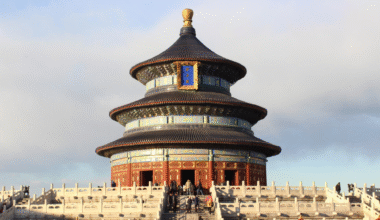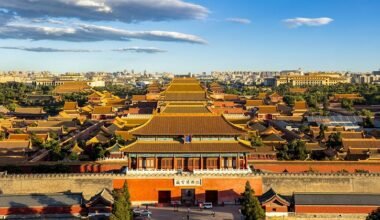I. Introduction: Walking into the Heartbeat of Beijing
If Beijing is a city steeped in three millennia of civilization, then Tiananmen Square is its ever-beating heart. It is not only a symbol of China but also a spiritual landmark that carries the weight of history, authority, memory, and culture. Every morning, as the first ray of sunlight hits the Tiananmen Gate Tower, the national flag rises solemnly to the sound of the national anthem, attracting countless visitors from across the country who stop in reverence.

A trip to Beijing without visiting Tiananmen Square is like going to Paris without seeing the Eiffel Tower. It is a must-see destination for every traveler to China’s capital.
II. History of Tiananmen: From Imperial Symbol to Republic Landmark
Tiananmen, originally named “Chengtianmen,” was built during the Yongle reign of the Ming Dynasty in 1420. It served as the main gate of the Imperial City and the front facade of the Forbidden City. During the Ming and Qing dynasties, emperors used it to issue imperial edicts and hold grand ceremonies, making it a symbol of imperial power in ancient China.
In the eighth year of the Shunzhi reign (1651) during the Qing Dynasty, the gate was rebuilt and renamed “Tiananmen,” meaning “Gate of Heavenly Peace,” symbolizing the mandate of heaven and the stability of the nation. The gate tower stands 33.7 meters high, with a large inscription in the center reading “Long Live the People’s Republic of China.” From the tower, one can overlook the entire square and Chang’an Avenue, making it one of the most iconic political landmarks in China.
On October 1, 1949, Chairman Mao Zedong declared the founding of the People’s Republic of China from atop the Tiananmen Gate Tower, marking the birth of New China. From that moment, Tiananmen became a symbol of the people’s nation, no longer merely an imperial facade. National Day parades, important celebrations, and flag-raising ceremonies are all held here.
Today, Tiananmen Square is one of the largest city squares in the world, covering an area of 440,000 square meters and capable of accommodating over a million people, continuing the legacy of its rich history.
III. Attractions Around Tiananmen: History Beneath Your Feet
Tiananmen Square itself is a remarkable site, but its surroundings are also filled with historical and cultural landmarks that are not to be missed.
1. Tiananmen Gate Tower
Climbing to the top of the Tiananmen Gate Tower is a popular activity among visitors. From the top, one can enjoy a panoramic view of the square, Chang’an Avenue, and the Great Hall of the People, feeling the grandeur and solemnity of the nation’s political center. Tickets are required, and visitors must pass through security checks; early reservations are recommended.
2. Monument to the People’s Heroes
Located at the center of the square, the Monument to the People’s Heroes was erected in 1958 to commemorate those who sacrificed their lives in the struggle for national independence. Standing 37.94 meters tall, the monument bears the inscription “Eternal Glory to the People’s Heroes” in golden characters penned by Mao Zedong. Reliefs on all four sides depict major historical events from the Opium War to the Liberation War, presenting a stone-carved narrative of modern Chinese history.
3. Chairman Mao Memorial Hall
South of the monument stands the Chairman Mao Memorial Hall, the resting place of Mao Zedong. The atmosphere inside is solemn and respectful; visitors are expected to dress properly and maintain silence. Admission is free but requires waiting in line and passing security checks. Early morning visits are recommended due to lower crowd levels.
4. Great Hall of the People
Situated on the western side of the square, the Great Hall of the People is where the National People’s Congress and important national events, including National Day galas, are held. The building’s exterior is grand and imposing, while the interior is magnificently decorated. It is open to tourists during certain periods.
5. National Museum of China
To the east of the square lies the National Museum of China, a treasure trove of Chinese history and art. Its vast collection includes artifacts ranging from prehistoric relics to modern cultural exhibits. It is a perfect destination for those looking to deepen their understanding of China’s civilization. Entry is free with ID registration, but booking in advance is advised.
IV. Local Cuisine Near Tiananmen: Tastes of the Capital
Exploring Tiananmen is not just a journey through history but also an opportunity to savor traditional Beijing cuisine.
1. Quanjude Roast Duck
A short drive from Tiananmen is the famous Quanjude Roast Duck Restaurant. Founded in 1864, it is known for its crispy skin and tender meat. Dining here is a culinary experience deeply rooted in Beijing culture.
2. Beijing Snacks at Huguosi Street
Huguosi Snack Street, located within walking distance or a short subway ride, offers a variety of Beijing-style street foods such as fried dough rings (Jianbing), sugar-coated haws (Tanghulu), and steamed buns (Baozi). Affordable, flavorful, and deeply local, these snacks are a must-try.
3. Qianmen Street Dining
Qianmen Street, south of Tiananmen, is a popular pedestrian shopping and dining area that blends traditional and modern architecture. Numerous local restaurants and teahouses provide authentic Beijing cuisine in a more casual, scenic atmosphere.
V. Visiting Tips: How to Make the Most of Your Tiananmen Trip
- Best Time to Visit: Spring and autumn offer the most pleasant weather. Arriving early in the morning is recommended to avoid crowds and witness the flag-raising ceremony.
- Security Check: Entry to the square requires security screening. Carry a valid ID (passport for foreigners), and avoid bringing large bags or restricted items.
- Photography: Photography is allowed in most areas, but drone use is prohibited. Be respectful when taking photos near the Chairman Mao Memorial Hall.
- Transportation: The nearest subway stations are Tiananmen East and Tiananmen West (Line 1). Public transport is efficient and convenient.
- Time Allocation: At least half a day is recommended to fully explore the square and its surrounding attractions. Museums and memorial halls may require separate bookings.
VI. Conclusion: A Square of Stories, a Landmark of Legacy
Tiananmen Square is more than just a tourist destination; it is a place where the echoes of emperors, revolutionaries, and citizens converge. Every step you take here is steeped in the legacy of a nation’s transformation. From ancient imperial rites to modern national pride, Tiananmen remains the center of China’s historical narrative.
Whether you are a first-time visitor or a returning traveler, standing in Tiananmen Square offers a profound perspective on China’s past, present, and aspirations for the future. Be sure to bring your curiosity, your respect, and your camera—for this is where history stands still, and yet, never stops moving.

